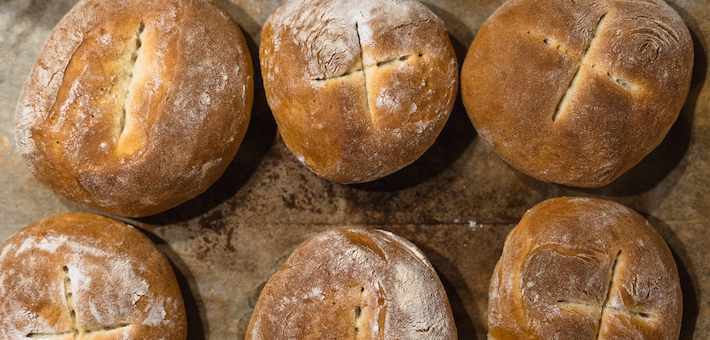Commentary on John 6:1-21
Our narrator places the Bread Discourse in the middle of the Book of Signs (John 1-12). It feels like a centerpiece. The present verses include two miracles: John’s version of the multiplication of loaves for the 5,000 (the only miracle included in all four Gospels) and Jesus walking on water.
In the opening scene of this text, the narrative gives readers what might be the equivalent of a Johannine compass reading: the mountain, the students and their teacher, the occasion (the Passover), the crowds, and even the boat and stormy sea point to Jesus’ centrality in John’s Gospel. Our narrator views Jesus’ miracles as signposts leading to God’s glory. In the Synoptics, Jesus often responds to human need with acts born of deep emotion. In John, Jesus often seems unmoved (almost) by the distress around him (for example, John 2:4 and 11:5). Also, here the narrator does not show Jesus spilling over with compassion for the hungry (as in Mark 6:34). John’s narrator informs us that Jesus, knowing the hunger of the crowd, intends to administer a test (verse 6a). Like the story of the raising of Lazarus, the Johannine Jesus lives on two planes, the theological and the human, simultaneously and without contradiction.
Biblical allusions abound in this chapter. John’s account of the Feeding of the Five Thousand contains echoes of Elijah-Elisha stories (for example, 2 Kings 4:42-44) and allusions to the Psalms, especially Psalm 107:4-5, 23, and 28-30. The narrator uses eucharistic language but in a different form than is found in the Synoptics. Gail R. O’Day complains that interpreters often go to John looking for the Synoptic version of an institution text—instead, she suggests that it might be more helpful if we use Johannine categories.1
Consider, for example, how the Johannine category of personal intimacy with Jesus works as a lens for this text. Like the Last Supper in the Synoptics—and unlike the Synoptic multiplication stories—Jesus distributes the bread and fish by his own hand (verse 11). The Synoptic tradition of an ecclesial hierarchy (implied by the disciples who distribute bread) gives way in John to direct communion with Jesus. If this is not Jesus’ “last” supper, one upshot might be that the Johannine world accents Jesus’ eucharistic presence with the believer in the totality of life.
Readers often experience John as logos heavy, but this gospel can also be refreshingly direct at times. In the Synoptics, Jesus takes bread; in John, Jesus takes barley loaves. This uniquely Johannine detail adds realism as well as a social location to this meal. Barley, according to Raymond E. Brown, was the bread commonly available to the poor. It may also recall the story of Ruth, who returns with Naomi during the barley harvest. In rabbinic interpretations, Boaz’s gift to Ruth anticipates the messianic banquet for the poor. Brown also calls our attention to the realism relative to the fish: while the Synoptics use ichthys, the well-known Christian acronym for Jesus’ saving significance, John uses opsarion or “dried fish.” 2 John’s high Christology does not diminish the realism of real food meant for real hunger.
Jesus’ public approval skyrockets with people wondering whether he is “the prophet who is to come into the world” (verse 14b) while still others see an opportunity to conscript Jesus for some earthly campaign. According to the NRSV, Jesus “withdraws” (verse 15) from their coercion tactics; a more difficult and literal translation would be the one proposed by Brown: “so he fled back to the mountain alone.” The disciples, left to their own lights, take the initiative and push out to sea (verse 17).3
Darkness makes one of eight appearances in this Gospel: “It was now dark, and Jesus had not yet come to them” (verse 17b)—the crowd is gone and crucially, so is Jesus.4 As our gaze turns to the disciples in the boat, we see a vivid picture of John’s pastoral approach to the human condition. Unlike the Synoptics where the story is told from Jesus’ perspective (see Mark 6:48), the narrator puts the reader in the boat with the disciples, as those who look for Jesus in the growing chaos and darkness of a stormy sea. Perhaps it is no accident that what follows is the second instance of Jesus’ use of the “I am” statement (verse 20) 5—and with it, a sense of impassable distance, a yearning seems to vanish in an instant.
Reflection
Sometimes it feels as if we want Jesus on our terms, and when that’s the case, we don’t want Jesus, but rather our fill.
Instead of getting our fill, John would have us see Jesus, the One who is the messianic banquet for the poor. What does that mean? Maybe we struggle to fix our eyes on Jesus because we love darkness rather than the light that comes into the world. John places the community that has chosen to follow Jesus in the boat with the disciples, on a rough sea under cover of night, wanting but not having Jesus in their possession (verse 21). How many times in the past two years have the winds and waves of pandemic and social upheaval gripped our congregations and narrowed our imaginations?
We want to take Jesus into our boat, enlisting Jesus in our causes.
Or have we in the turmoil of the last year or so begun to recognize the nearness of Jesus, which is not the same as physical possession?
Photographer Sally Mann quotes one of her father’s diary entries in her memoir, Hold Still: “Do you know how a boatman faces one direction, while rowing in another?”6 In an Alcoholics Anonymous group, Rudy says that he has learned to see the past as a reference point but not as a residence. Yet, as we pull at the oars, our physical gaze only takes in where we’ve been. How will we ever get to our destination? “The brutal truth,” according to James K. A. Smith, is this: “You can’t get there from here. Not even a map is enough. You might already have realized where you need to go, but the question is how to get there. What if God sent a boat? What if the Creator captained a ferry from that other shore?”7
Notes
- Gail R. O’Day, “John: Introduction, Commentary, and Reflections” in The New Interpreter’s Bible: Luke and John, volume 8 (Nashville: Abingdon Press, 2015), 516.
- Raymond E. Brown, The Gospel According to John: Introduction, Translation, and Notes in The Anchor Bible (Garden City: Doubleday & Company Inc., 1966), 246.
- Brown, The Gospel According to John, 231 (my italics).
- For the frequency and meaning of light-darkness vocabulary, see Brown’s “Johannine Vocabulary” (Appendix I) in The Gospel According to John, 515-6.
- See O’Day’s helpful organization of the “I am” sayings in “Figure 2: The “I AM” Sayings in John” in “John” in New Interpreter’s Bible, 511.
- Sally Mann, Hold Still (New York: Little, Brown, 2015), 361 quoted in James K. A. Smith, On the Road with Saint Augustine: Real World Spirituality for Restless Hearts (Grand Rapids: Brazos Press, 2019), xiii.
- Smith, On the Road with Saint Augustine, 14.



July 25, 2021